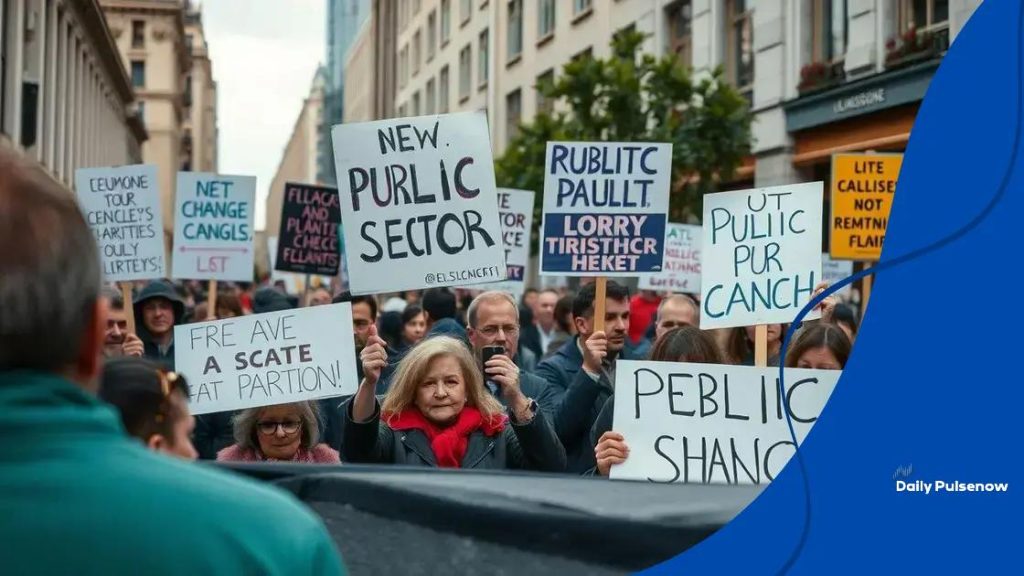Public sector protests: understanding the motivations

Anúncios
Public sector protests are organized demonstrations by citizens advocating for social change and government accountability, utilizing technology and global collaboration to amplify their impact and drive policy reforms.
Public sector protests have become a common sight across many regions, where citizens rally for change and advocate for their rights. But what fuels these movements? Let’s delve into the underlying factors that drive these demonstrations.
Anúncios
Key reasons behind public sector protests
Understanding the key reasons behind public sector protests can provide valuable insights into the motivations of citizens and their demands for change. These protests often arise from a combination of social, economic, and political factors that resonate across different communities.
Economic Factors
One of the primary drivers of public sector protests is economic hardship. People may feel that their rights are being compromised as a result of austerity measures or budget cuts. As public services diminish, protests become a platform for expressing dissatisfaction. This sentiment can be particularly strong in areas where job security is low.
Demand for Better Working Conditions
Another significant reason for unrest is the demand for better working conditions among public sector employees. Workers often seek fair wages, adequate resources, and safe environments to fulfill their roles effectively. When these needs are unmet, individuals are more likely to voice their concerns through protests.
Anúncios
- Increased job satisfaction can lead to better public service delivery.
- Fair wages attract qualified professionals to public sector roles.
- A safe work environment fosters productivity and morale.
Political factors also play a crucial role in fueling public sector protests. Citizens often feel that their voices are not being heard by those in power. When decisions are made without public consultation, frustration can build, leading to protests as a means of demanding accountability and transparency.
Social Justice and Equality
Issues of social justice and equality are central to many protests. Citizens advocate for equal treatment, fair representation, and social empowerment. When marginalized groups feel discriminated against, they often unite to demand their rights through public demonstrations.
- Protests can highlight systemic inequalities within public service.
- Mobilizing for a common cause fosters community solidarity.
- Advocacy for social change can influence policies and reforms.
In summary, factors such as economic struggles, demands for improved working conditions, political accountability, and social justice are pivotal reasons behind public sector protests. Each protest serves as a beacon for change, encouraging communities to unite and push for the reforms they seek.
Recent trends in public sector demonstrations
Recent trends in public sector demonstrations reflect the growing desire for change and accountability in many societies. As citizens face evolving challenges, their methods of protest are also adapting to the times.
The Rise of Digital Protests
With the advancement of technology, many public sector demonstrations now incorporate social media. This platform allows for quicker organization and broader reach, ensuring that messages are amplified across various channels. Activists can create events, share content dynamically, and mobilize supporters like never before.
- Social media campaigns provide real-time updates and highlights from protests.
- Hashtags help unify the movement and make them easily searchable.
- Online petitions can gather support and pressure decision-makers.
Moreover, the use of live streaming during protests has become common. This allows activists to showcase events as they happen, making it harder for authorities to suppress the movement. This new medium fosters transparency and can attract global attention.
Coalition Building Across Sectors
Another significant trend in recent years is the coalition-building among different groups. Public sector workers are increasingly collaborating with civil rights organizations, environmental groups, and other activists. These alliances strengthen protests by highlighting interconnected issues such as social justice and sustainability.
- Coalitions can create a more powerful voice and broader impact.
- Addressing multiple grievances simultaneously attracts a diverse audience.
- Shared resources and strategies lead to more effective campaigns.
As the landscape of public sector demonstrations evolves, we also see a shift in the demographics of protesters. Participation is growing among younger generations, who are often fueled by a sense of urgency regarding climate change, education reform, and equitable healthcare. These passionate voices are leading the charge for robust changes in their communities.
The recent trends in public sector demonstrations indicate not just a response to growing dissatisfaction but a proactive approach to creating inclusive and effective movements. These movements are utilizing new technologies, building strong coalitions, and engaging a younger crowd to advocate for their rights and needs. Clearly, the future of these demonstrations will continue to evolve in exciting and impactful ways.
The role of social media in mobilizing protests

The role of social media in mobilizing protests has transformed the way movements are organized and executed. Today, platforms like Twitter, Facebook, and Instagram serve as powerful tools for activists to share their messages and rally support.
Instant Communication
One of the most significant advantages of social media is its ability to facilitate instant communication. Activists can quickly spread information about where and when protests will occur, allowing more people to participate. This immediacy helps engage individuals who may not have been aware of the issues at stake.
- Real-time updates keep participants informed and encourage engagement.
- Calls to action can be shared widely, reaching broader audiences.
- Availability of live feeds can keep those unable to attend connected.
Moreover, social media effectively connects diverse groups, creating a network of support that crosses geographical boundaries. Protesters in one location can interact and gain solidarity from like-minded individuals globally.
Hashtags and Trends
Hashtags play a critical role in social media activism. They allow users to aggregate content under specific topics, making it easier to track and join conversations. By using trending hashtags, protests can gain visibility and momentum, attracting more support.
- Hashtags can create a unified message, amplifying calls for change.
- Trending topics can bring national and international attention to local issues.
- Using specific hashtags allows for monitoring responses and engagement.
Social media also acts as a platform for storytelling. Activists share their personal experiences and motivations, creating emotional connections that inspire others to join the cause. These stories resonate deeply, making complex social issues more relatable and prompting people to take action.
Additionally, social media amplifies the voices of marginalized groups. It provides a space for those who might not be heard otherwise to express their views and concerns. This inclusivity enriches the dialogue surrounding protests and highlights the diverse perspectives within the movements.
Through its various features, social media has become an indispensable part of modern protest movements. It not only helps organize and mobilize efforts but also provides a powerful platform for raising awareness and fostering community. The impact of these online tools is reshaping the landscape of activism as individuals come together to demand change in innovative ways.
Impacts of protests on policy changes
The impacts of protests on policy changes are significant and often reshape the political landscape. When citizens come together to demand change, their collective voices can lead to meaningful reforms in various sectors.
Raising Awareness
One critical impact of protests is their ability to raise public awareness about specific issues. Protesters bring attention to matters that may have been overlooked by lawmakers and the media. This increased visibility often encourages broader discussions and pushes the agenda into public discourse.
- Public protests can highlight social injustices that need addressing.
- Media coverage amplifies the messages of the protesters.
- Educational campaigns often emerge from the movements themselves.
As awareness grows, pressure mounts on policymakers to respond. Lawmakers may find it politically advantageous to address the issues raised by protests to maintain their support among constituents.
Influencing Legislation
Protests can also serve as a catalyst for legislative action. When large groups advocate for specific policies, they create an environment where change is not just desired but necessary. Historical examples show how sustained protests lead to new laws and reforms. For instance, movements focused on civil rights and environmental regulations have resulted in legislative changes that reflect the demands of the people.
- Successful protests can lead to new laws that protect citizens’ rights.
- Legislation often incorporates solutions proposed by activists.
- Policy changes can result in increased funding for important public services.
Moreover, protests can shift the priorities of government agencies. When citizens demonstrate their needs, agencies may realign their objectives to better serve the public. This responsiveness is crucial for fostering trust between the government and the community.
In some cases, the effects of protests can inspire international attention and influence global policies. Grassroots movements that gain traction can serve as models for activism worldwide, creating waves of change that transcend borders. This global solidarity amplifies the pressure on national governments to respond.
The impacts of protests on policy changes highlight the power of collective action. By raising awareness, influencing legislation, and reallocating governmental priorities, protests play a vital role in shaping the policies that affect our lives. As citizens unite to voice their concerns, they create pathways for achieving meaningful reforms and sparking lasting change.
Future outlook for public sector activism
The future outlook for public sector activism appears dynamic and full of potential. As societal issues continue to evolve, so do the strategies and goals of activists. Increased awareness and engagement can be expected in the coming years.
Emerging Technologies
As technology advances, activists are likely to use new tools to enhance their efforts. For example, virtual reality (VR) and augmented reality (AR) can create immersive experiences that educate people about social issues. These technologies can make protests more impactful, drawing in participants who may not be physically present.
- Innovative tech can help visualize data and statistics effectively.
- Engaging content can attract a younger audience interested in activism.
- Online platforms will continue to play a crucial role in organizing movements.
Additionally, the use of artificial intelligence (AI) may help analyze trends and predict outcomes. This insight can guide activists in their strategies, making their movements more effective.
Interconnected Global Movements
The interconnectedness of global activism will likely grow stronger. Movements around the world can learn from each other, sharing successful tactics and strategies. This solidarity will empower local activists, as they realize they are part of a larger global fight for justice.
- Shared resources can enhance the effectiveness of local campaigns.
- Global networks can create a supportive community for activists.
- Collaborative initiatives can strengthen the overall message and impact.
This international collaboration can lead to more significant changes, as activists unite to address common challenges, such as climate change, inequality, and oppression.
Moreover, younger generations are increasingly engaged in activism. With access to information and communication tools, they can mobilize quickly. This new wave of activists brings fresh perspectives and innovative ideas, pushing for transformative changes in society.
The future of public sector activism will also rely on the continued support from allies and organizations. Building coalitions with various groups can amplify voices and broaden influence. Achieving significant change often requires collaboration among diverse sectors.
As we look ahead, it’s clear that public sector activism will remain a vital force in shaping policies and societal norms. The combination of emerging technologies, global interconnectedness, and younger voices will continue to drive movements forward, making a lasting impact on communities around the world.
FAQ – Frequently Asked Questions about Public Sector Activism
What is public sector activism?
Public sector activism involves citizens advocating for changes in government policies and services to address social issues and improve public welfare.
How does technology impact public sector activism?
Technology enhances communication and organization among activists, allowing them to mobilize quickly and effectively share their messages across various platforms.
Why is youth involvement important in activism?
Youth involvement brings fresh perspectives and innovative ideas, ensuring that movements remain relevant and can address current challenges effectively.
What is the future outlook for public sector activism?
The future outlook is promising, with increased collaboration, leveraging of new technologies, and ongoing engagement from diverse communities expected to drive meaningful change.